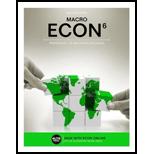
Sub-part
A
The shifts and directions of aggregate
Concept introduction
Aggregate demand: Aggregate demand is the demand of the final goods which are produced in the economy in a given year.
Sub-part
B
The shifts and directions of aggregate demand and supply curve when the consumer confidence declines and its effect to output and price level.
Concept introduction
Aggregate demand: Aggregate demand is the demand of the final goods which are produced in the economy in a given year.
Aggregate supply: Aggregate supply curve shows the relationship between the goods supplied by nations' suppliers and nation's overall price level.
Sub-part
C
The shifts and directions of aggregate demand and supply curve when the supply of resources increases and its effect to output and price level.
Concept introduction
Aggregate demand: Aggregate demand is the demand of the final goods which are produced in the economy in a given year.
Aggregate supply: Aggregate supply curve shows the relationship between the goods supplied by nations' suppliers and nation's overall price level.
Sub-part
D
The shifts and directions of aggregate demand and supply curve when the wage rate increases and its effect to output and price level.
Concept introduction
Aggregate demand: Aggregate demand is the demand of the final goods which are produced in the economy in a given year.
Aggregate supply: Aggregate supply curve shows the relationship between the goods supplied by nations' suppliers and nation's overall price level.
Trending nowThis is a popular solution!

Chapter 5 Solutions
ECON MACRO (with MindTap Printed Access Card) (New, Engaging Titles from 4LTR Press)
- Given the following petroleum tax details, calculate the marginal tax rate and explain its significance: Total Revenue: $500 million Cost of Operations: $200 million Tax Rate: 40% Additional Royalty: 5% Profit-Based Tax: 10%arrow_forwardUse a game tree to illustrate why an aircraft manufacturer may price below the current marginal cost in the short run if it has a steep learning curve. (Hint: Show that learning by doing lowers its cost in the second period.) Part 2 Assume for simplicity the game tree is illustrated in the figure to the right. Pricing below marginal cost reduces profits but gives the incumbent a cost advantage over potential rivals. What is the subgame perfect Nash equilibrium?arrow_forwardAnswerarrow_forward
- M” method Given the following model, solve by the method of “M”. (see image)arrow_forwardAs indicated in the attached image, U.S. earnings for high- and low-skill workers as measured by educational attainment began diverging in the 1980s. The remaining questions in this problem set use the model for the labor market developed in class to walk through potential explanations for this trend. 1. Assume that there are just two types of workers, low- and high-skill. As a result, there are two labor markets: supply and demand for low-skill workers and supply and demand for high-skill workers. Using two carefully drawn labor-market figures, show that an increase in the demand for high skill workers can explain an increase in the relative wage of high-skill workers. 2. Using the same assumptions as in the previous question, use two carefully drawn labor-market figures to show that an increase in the supply of low-skill workers can explain an increase in the relative wage of high-skill workers.arrow_forwardPublished in 1980, the book Free to Choose discusses how economists Milton Friedman and Rose Friedman proposed a one-sided view of the benefits of a voucher system. However, there are other economists who disagree about the potential effects of a voucher system.arrow_forward
- The following diagram illustrates the demand and marginal revenue curves facing a monopoly in an industry with no economies or diseconomies of scale. In the short and long run, MC = ATC. a. Calculate the values of profit, consumer surplus, and deadweight loss, and illustrate these on the graph. b. Repeat the calculations in part a, but now assume the monopoly is able to practice perfect price discrimination.arrow_forwardThe projects under the 'Build, Build, Build' program: how these projects improve connectivity and ease of doing business in the Philippines?arrow_forwardhow utillity relate to microeconomics ?arrow_forward
 Economics (MindTap Course List)EconomicsISBN:9781337617383Author:Roger A. ArnoldPublisher:Cengage Learning
Economics (MindTap Course List)EconomicsISBN:9781337617383Author:Roger A. ArnoldPublisher:Cengage Learning









